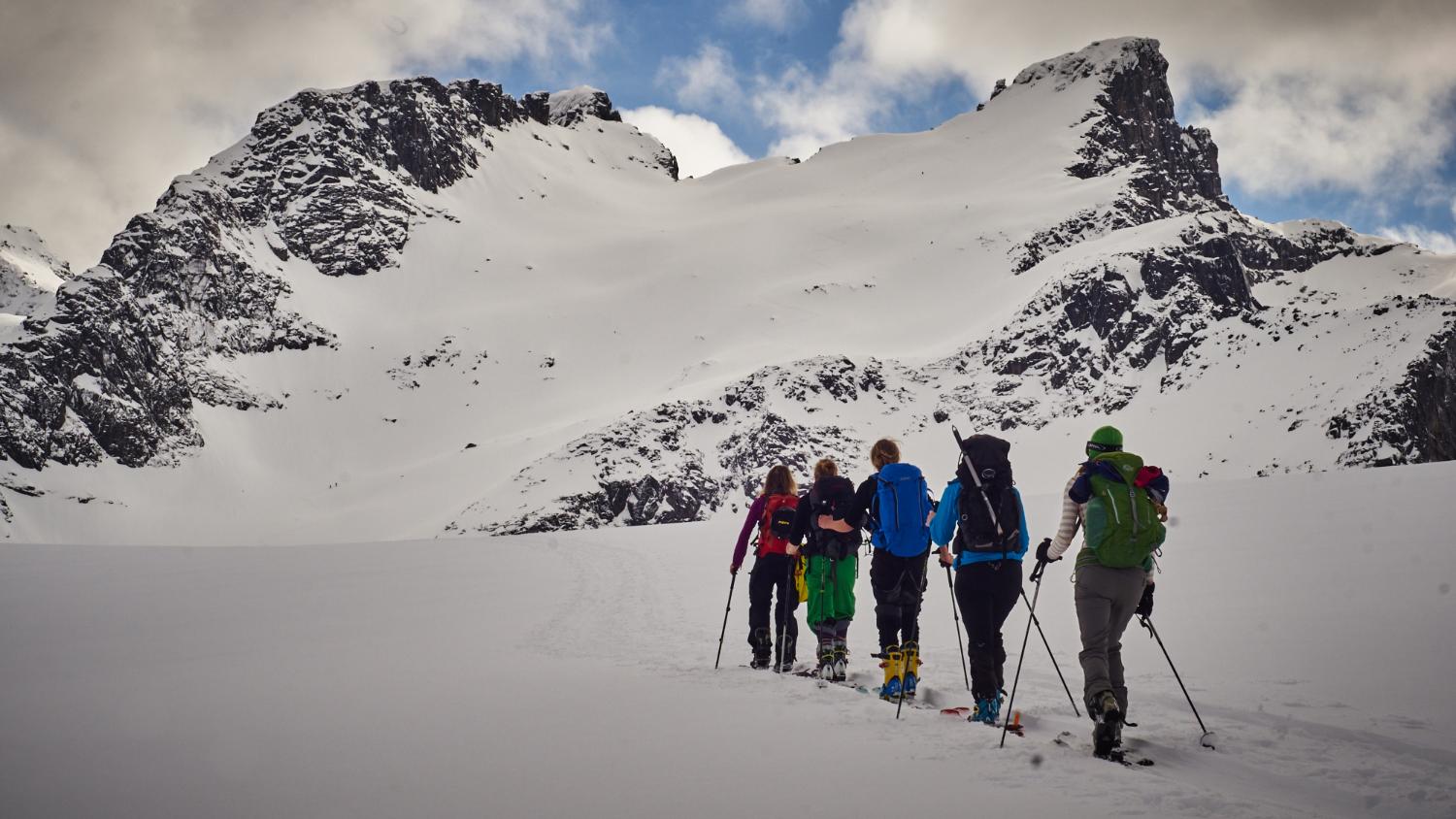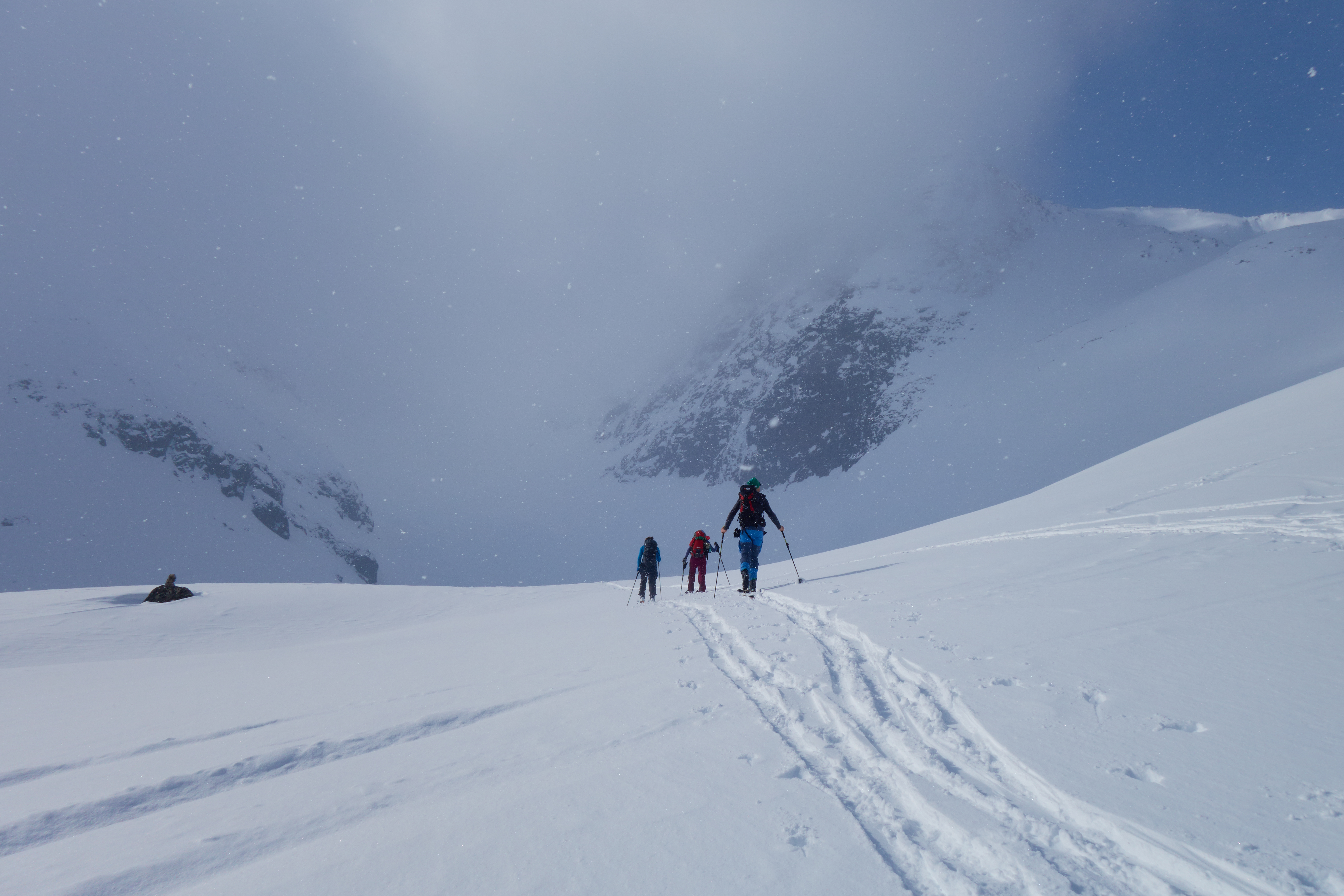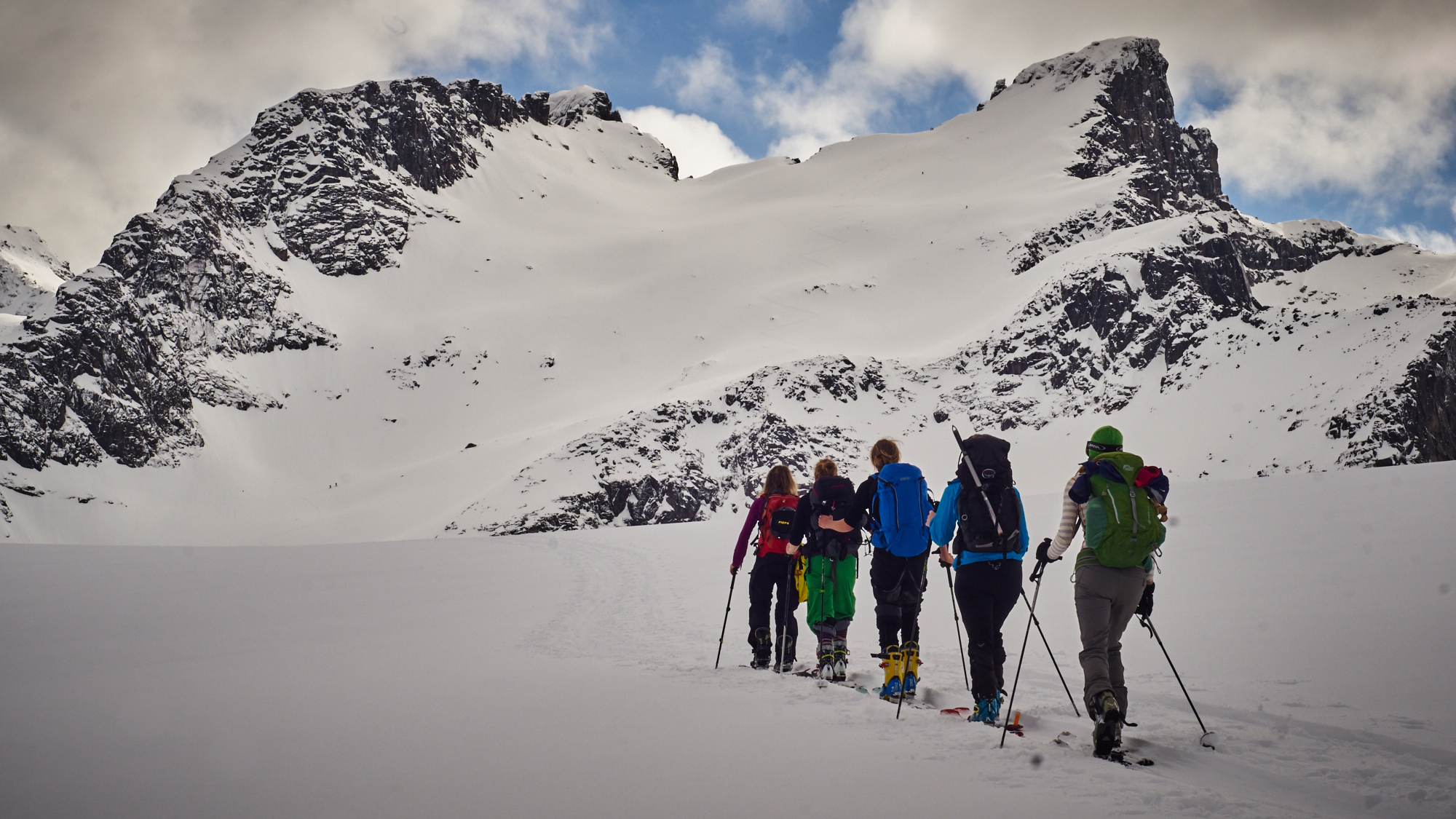The White Heat Project

The risks we take, and the lives we make - effects of positional preferences and bounded rationality on risk-taking behavior" is a 4-year research project funded by the Norwegian Research Council (RCN: 262626). The project has been given the nickname "White Heat Project". The main aim of the White Heat Project is to analyze motivating factors behind risk-taking in avalanche terrain, with a special focus on social factors. Our international research team consists of researchers in economics, psychology, geography, snow science and political science.
The White Heat Project is a cross-disciplinary 4-year research project funded by the Norwegian Research Council. The research team consists of researchers in behavioral economics, psychology, snow science, geography and political science.
White Heat aims to identify factors that motivate backcountry riders to expose themselves to excessive risk, and to analyze how cognitive biases affect decision making in avalanche terrain. We hope that our findings can be used to reduce the number of avalanche incidents, but also that the results will increase the understanding of decision-making under uncertainty in risky environments other than avalanche terrain.
Our research framework builds on previous research, which show that human behavior rarely matches that Homo Economicus, who rationally weighs benefits to costs. Rather, we are social and emotional beings, and in spite of our relatively large brain, we sometimes lack the capacity to make good decisions.
White heat has three overarching research questions:
Does our need to be an accepted and respected member of a social group (i.e., backcountry riders) affect our willingness to expose ourselves to risk?
How does incidental moods and arousal, such as “stoke” affect risk perception and risk tolerance?
Does trends in, and the relative level of hazard, affect our perception of the hazard?
Thus far, we have analyzed motivating factors behind decisions in the backcountry among Norwegian and American skiers. Our results suggest that choices in avalanche terrain are affected by both rational and irrational factors. On the rational side, we find that backcountry travel skills, attitudes to and perception of risk affect preferences for terrain. Our results further suggest that individuals with formal avalanche training are less willing to ski relatively risky terrain. This is reassuring!
However, we also find that the presence of a more experienced skier reduces perceived risk, even when this presence adds no new information about actual risk, and that individuals who look up to people who ski steep or exposed terrain, are more willing to ski down risky runs.
In our American sample, we find that about a third of the sample experience a reduction in wellbeing if other riders ski more challenging terrain than they do, and an increase in wellbeing if they ski more challenging terrain than others do. These individuals are more likely to post pictures of bold lines on social media, more likely to talk to friends about bold lines, and more likely to perceive that riding steep terrain is associated with social respect, than are individuals who do are not affected by other riders skiing activities. Most importantly, our results suggest that positional riders are more likely to accept to ski potentially risky terrain, regardless of their level of avalanche training.
End: February 26. 2022
Unit: Tromsø University Business School
Funding:
Research Council of Norway (RCN)Participants:
Hanna Andrea MannbergAudun Hetland
Tomas Sjogren
Jordy Hendrikx
Results:
- Who's at risk in the backcountry? (Academic lecture)
- Are you keeping up with Jeremy Jones? Effects of positional concerns on risk taking behavior (Academic lecture)
- Who's at risk in the backcountry? Effects of individual characteristics on hypothetical terrain choices (Academic article)
- Planen var å gå en kort tur for å se et heng vi ikke hadde kjørt før (Interview)
- Hvorfor tar vi risiko I fjellet? (Interview)
- How risky is it? Perceived risk among Norwegian backcountry riders (Poster)
- Keeping up with Jeremy Jones – effects of positional preferences on risk-taking behavior (Academic lecture)
- Are they experts? Self-assessed backcountry skills among backcountry skiers in Norway and North America (Poster)
- Do recent trends in forecasted avalanche danger affect our perception of the current avalanche hazard? (Poster)
- Communicating public avalanche warnings – what works? (Academic article)
- Vem hamnar i en lavin? The White Heat Project (Academic lecture)
- Etter skredet (Interview)
- Klar for vinteren? (Popular scientific lecture)
- Klar for vinteren? Skredseminar i Trondheim (Popular scientific lecture)
- The risks we take and the life we make (Academic lecture)
- Are you keeping up with the (Jeremy) Joneses? An attempt to link social aspirations to risk-taking behavior in avalanche terrain (Academic lecture)
- Sharp while ascending? How high arousal impact cognitive performance (Poster)
- Er du Einstein eller Homer: Hvem havner i snøskred? (Popular scientific lecture)
- Are you sharp while ascending? (Poster)
- Er du Homer eller Einstein - Hvem havner i snøskred? (Popular scientific lecture)
- Er du Homer eller Einstein - Hvem havner i snøskred? (Popular scientific lecture)
- Er du Einstein eller Homer - Hvorfor havner vi i snøskred? (Popular scientific lecture)
- Er du Einstein eller Homer - Hvorfor havner vi i snøskred? (Popular scientific lecture)
- I'm on top of things, you are not - Backcountry riders evaluation of own and other's risk-taking behavior (Academic lecture)
- Risky Positioning - Social Aspirations and Risk Taking Behavior in Avalanche Terrain (Lecture)
- Powder arousal and decision-making (Lecture)
- Positional Preferences (Academic lecture)
- Powder Arousal and the White Heat Project (Academic lecture)
- Powder Arousal and the White Heat Project (Academic lecture)
- Powder Arousal and the White Heat Projec (Academic lecture)
- Rethinking the Heuristic Traps Paradigm in Avalanche Education: Past, Present and Future (Academic article)
- Developing nationwide avalanche terrain maps for Norway (Academic article)
- Social Signalling (Popular scientific article)
- Social Signalling matters (Popular scientific lecture)
- Er du Einstein eller Homer? Eller, hvorfor havner vi i snøskred? (Popular scientific lecture)
- Er du Einstein eller Homer? Eller, hvorfor havner vi i snøskred? Polaria (Popular scientific lecture)
- Snow Science - Human Factors (Lecture)
- Snow Science - Human factors - Puget Sound (Lecture)
- Risky positioning–social aspirations and risk-taking behaviour in avalanche terrain (Academic article)
- What's Economics got to do with it? An economic perspective on decision-making in avalanche terrain (Lecture)
- Skredpodden EP4 - Kameratredning i snøskred (Programme participation)
- Skredpodden EP5 - Utstyr til kameratredning (Programme participation)
- How Decision Making is Critical for Back Country Skiers and Sex - Behavioral Grooves podcast (Interview)
- Husky #253. Panelsamtal om beslutsfattande i lavinterräng (Interview)
- Skredpodden EP9 Fornuft og Følelser (Programme participation)
- Skredpodden EP 1 Sesongstart, hva bør jeg tenke på? (Sound material)
- Skredpodden EP 2 Skredterreng hva er det? (Sound material)
- Skredpodden EP 3 Skredvarselet, hva er det og hvordan bruker vi det? (Sound material)
- Skredpodden AKTUEL: Snødekkeoppdatering (Sound material)
- Skredpodden EP 5 Utstyr til kammeratredning (Sound material)
- Skredpodden EP 6 Snøskuter og snøskred (Sound material)
- Skredpodden EP 7 Skifilm og risiko (Sound material)
- Skredpodden EP 8 Skifilm og risiko med Nikolai Schirmer del 2 (Sound material)
- Skredpodden EP 10 Skifilm og risiko, hva gjør det med den som ser? (Sound material)
- Skredpodden EP 12 Skredvarslingen, hvordan er den organisert og hvordan bidrar den til trygge valg (Programme management)
- Skredpodden EP 13 En hverdagskriger om skifilm, risiko og beslutningstaaking. Asbjørn Eggebø Næss (Programme management)
- Skredpodden EP 14 Førstehjelp i fjellet (Programme management)
- Skredpodden EP 15 Førstehjelp og risikovurdering (Programme management)
- Skredpodden EP 16 Den profesjonelle redningstjenesten (Programme management)
- Skredpodden EP 17 Vedvarende svake lag, hva er det? (Programme management)
- Skredpodden EP 18 Snøskred og vei (Programme management)
- I dag kan du høyra første episode i skredpodden (Interview)
- Powder fever and its impact on decision-making in avalanche terrain (Academic article)
- DOES POWDER FEVER CLOUD OUR JUDGEMENT? (Interview)
- Are you keeping up with Jeremy Jones? (Popular scientific article)
- Who's at risk in the backcountry? (Popular scientific article)
- Kjernen med hjernen (Interview Journal)
- no title (Interview Journal)
- TV4-Nyheterna 08.00 8 april 2021 (Interview)
- Därför tar vi risker trots lavinfara (Interview)
- Andrea var nära att dö i lavin: "Två meter snövägg rusade mot mig" (Interview)
- Lavinolyckan väckte hennes forskarlust (Interview)
- Trosser skredfare: - Mange vil utsette seg for større risiko for å bli akseptert av andre (Interview)
- Skredpodden EP 11 - Å være gruppe på tur (Programme participation)
- Terrain Use as a Lens For Understanding Decision making in Avalanche Terrain (Popular scientific article)
- Watching the Crowd: Terrain Use as a Lens for Understanding Decision Making in Avalanche Terrain (Popular scientific article)
- Trend effects on perceived avalanche hazard (Academic lecture)
- Trend effects on perceived avalanche hazard (Academic lecture)
- Care Panelen - Derfor må vi følge 10 000 mennesker over 10 år (Lecture)
- Social signalling matters (Academic lecture)
- Är du Einstein eller Homer på berget? Hur vår hjärna jobbar med och mot oss i lavinterräng (Popular scientific lecture)
- Er du Einstein eller Homer på tur? Hvordan vår hjerne jobber med og imot oss i skredterreng (Popular scientific lecture)
- Social identity and risky leisure activities: implications for welfare and policy (Academic article)
- With whom, and about what, do we compete for social status? Effects of social closeness and relevance of reference groups for positional concerns (Academic article)
- Skredpodden S2 EP7 - Frikjøring med Reine Barkered (Programme management)
- Skredpodden S2E8 - Skuter og skred (Programme management)
- Skredpodden EP11 - Interjvu med Linda Hallandvik om hvordan lære seg å ta gode beslutnigner i skredterreng (Programme management)
- Skredpodden S2 EP12 - En samtale med Karin Trolin om snø og vurderinger i skredterreng (Programme management)
- The CARE panel and Social Signalling matters (Lecture)
- Andrea ble tatt av et stort snoskred følelsen av å nesten dø setter seg veldig dypt (Interview)
- Tracking decision-making of backcountry users using GPS tracks and participant surveys (Academic article)
- Trend effects on perceived avalanche hazard (Academic article)
 In this review article, we discuss the conclusions that can and cannot be drawn about FACETS, the heuristic traps identified by Ian McCammon in the early 2000's. We also discuss implications for future research.
In this review article, we discuss the conclusions that can and cannot be drawn about FACETS, the heuristic traps identified by Ian McCammon in the early 2000's. We also discuss implications for future research.
